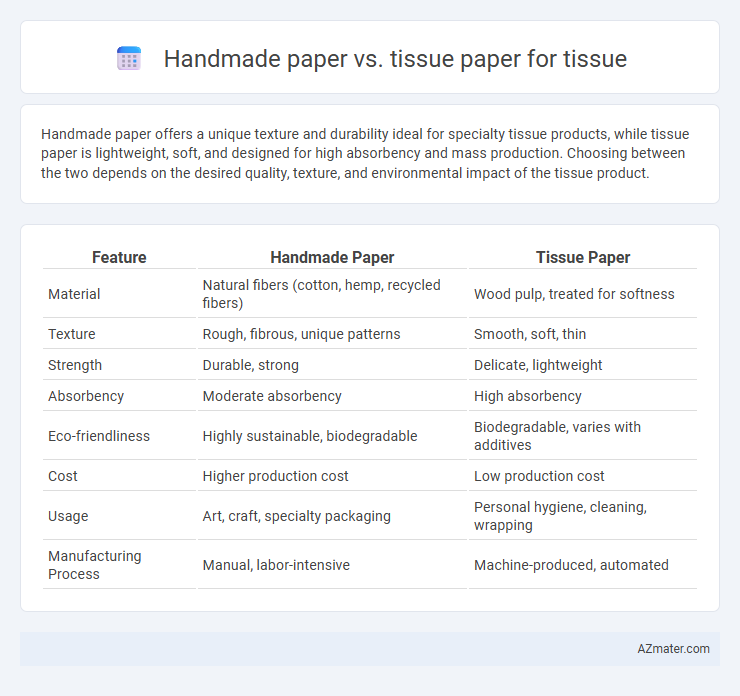Handmade paper offers a unique texture and durability ideal for specialty tissue products, while tissue paper is lightweight, soft, and designed for high absorbency and mass production. Choosing between the two depends on the desired quality, texture, and environmental impact of the tissue product.
Table of Comparison
| Feature | Handmade Paper | Tissue Paper |
|---|---|---|
| Material | Natural fibers (cotton, hemp, recycled fibers) | Wood pulp, treated for softness |
| Texture | Rough, fibrous, unique patterns | Smooth, soft, thin |
| Strength | Durable, strong | Delicate, lightweight |
| Absorbency | Moderate absorbency | High absorbency |
| Eco-friendliness | Highly sustainable, biodegradable | Biodegradable, varies with additives |
| Cost | Higher production cost | Low production cost |
| Usage | Art, craft, specialty packaging | Personal hygiene, cleaning, wrapping |
| Manufacturing Process | Manual, labor-intensive | Machine-produced, automated |
Introduction: Understanding Handmade Paper vs Tissue Paper
Handmade paper is crafted through traditional methods using natural fibers like cotton or hemp, resulting in a textured, durable, and eco-friendly product with unique irregularities. Tissue paper, on the other hand, is mass-produced from wood pulp or recycled paper fibers, offering a thin, soft, and highly absorbent material primarily used for hygiene and packaging. Understanding the differences in production, texture, and application is essential for selecting the appropriate paper type for tissue-related uses.
Definition and Production Process
Handmade paper is crafted using natural fibers such as cotton or hemp, formed through a traditional manual process involving pulping, sheet formation on a mesh screen, and air drying, resulting in a textured, durable material. Tissue paper, typically made from recycled wood pulp or virgin fibers, undergoes industrial production with mechanical pressing and high-speed drying to create thin, lightweight sheets optimized for softness and disposable use. The distinct production methods directly influence the texture, strength, and application suitability of each paper type in tissue products.
Environmental Impact and Sustainability
Handmade paper, crafted from recycled fibers and natural materials, boasts a lower environmental impact due to its biodegradability and reduced chemical processing compared to tissue paper, which often relies on mass production involving bleaches and additives. The sustainability of handmade paper is enhanced by its use of renewable resources and minimal energy consumption, whereas tissue paper production tends to drive deforestation and higher carbon emissions. Choosing handmade paper supports eco-friendly practices by minimizing waste and promoting resource conservation in tissue manufacturing.
Raw Materials Comparison
Handmade paper for tissue production utilizes natural fibers such as cotton, hemp, or recycled textile waste, offering a thicker, more durable texture compared to tissue paper made from wood pulp, which is chemically processed for softness and mass production. The raw materials in handmade paper contribute to its eco-friendly and biodegradable qualities, while tissue paper's wood pulp base involves intensive deforestation and energy consumption. Choosing raw materials impacts the environmental footprint and functional properties, with handmade paper emphasizing sustainability and texture, and tissue paper prioritizing softness and cost-efficiency.
Texture, Appearance, and Quality
Handmade paper offers a unique texture with natural fiber irregularities, providing a tactile, artisanal feel often favored for luxury tissue products. Tissue paper typically features a smoother, thinner surface designed for softness and absorbency, making it ideal for everyday hygiene uses. In terms of quality, handmade paper is usually more durable and eco-friendly, while tissue paper excels in disposability and cost-effectiveness.
Performance: Absorbency and Strength
Handmade paper offers superior strength due to its longer fibers and dense texture, making it more durable for various tissue applications. Tissue paper excels in absorbency because of its thin, porous structure designed to quickly soak up liquids. Balancing performance, handmade paper provides enhanced durability while tissue paper maximizes absorbency for soft, efficient use.
Health and Skin Sensitivity
Handmade paper, often crafted from natural fibers without harsh chemicals, tends to be gentler on sensitive skin compared to conventional tissue paper, which may contain additives and synthetic materials causing irritation. Tissue paper designed specifically for facial use typically undergoes treatments to enhance softness and reduce allergens, making it more suitable for frequent use on delicate skin. Choosing handmade paper can benefit individuals with skin sensitivities by minimizing exposure to irritants and promoting a healthier, more natural option for tissue needs.
Cost and Accessibility
Handmade paper typically costs more than tissue paper due to its labor-intensive production process and use of natural fibers. Tissue paper is mass-produced using machines, making it more affordable and widely accessible in retail stores and online marketplaces. The cost-efficiency and easy availability of tissue paper make it the preferred choice for everyday use, while handmade paper is often reserved for special occasions or eco-friendly products.
Ideal Applications and Uses
Handmade paper offers a unique texture and durability, making it ideal for premium gift wrapping, artistic projects, and eco-friendly packaging. Tissue paper, characterized by its lightweight and softness, is best suited for cushioning delicate items, facial tissues, and disposable hygiene products. Choosing between handmade paper and tissue paper depends on the need for aesthetic appeal versus functional softness and disposability.
Conclusion: Choosing the Right Paper for Your Needs
Handmade paper offers superior texture, durability, and environmental benefits due to its natural fibers and artisanal production, making it ideal for crafts, luxury packaging, and artistic projects. Tissue paper, being lightweight, soft, and cost-effective, is better suited for everyday uses such as gift wrapping and disposable hygiene products. Selecting the right paper depends on the balance between aesthetic appeal, functional requirements, and budget constraints for tissue applications.

Infographic: Handmade paper vs Tissue paper for Tissue
 azmater.com
azmater.com